| "Air is the element of freedom." |
| — Iroh to Zuko.[1] |
Airbending, one of the four elemental bending arts, is the aerokinetic ability to control and manipulate currents of air. The peaceful Air Nomads utilized this type of bending in their everyday lives.
Air is the element of freedom.[1] The Air Nomads detached themselves from worldly problems and concerns; finding peace and freedom was the key to solving their difficulties in life. Airbenders continually sought spiritual enlightenment, and, as a result, all children born into the Air Nomads were benders. The first airbenders learned their art from the flying bison.[2]
The key to airbending is flexibility and finding and following the path of least resistance. Airbending is notable for being almost purely defensive, as well as the most dynamic of the four bending arts. Airbenders can overwhelm many opponents at once with large and powerful attacks that could prove fatal; however, due to the pacifist nature of the Air Nomads, such attacks are rarely used. Due to their aforementioned spirituality, they often adapt to the situation surrounding them and prefer evasive maneuvers as opposed to direct confrontation.
Origin
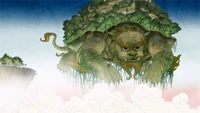
The air lion turtle would bestow the power to control air onto those venturing into the Spirit Wilds.
During the era of Raava, the power of airbending was temporarily bestowed on the inhabitants who lived on a giant lion turtle while they left the village to stock up on food. After the inhabitants permanently left the care of the lion turtle, airbenders learned to reconnect and refine their bending from the flying bison, a sacred creature in the Air Nomad culture.[2] The bison typically use their massive beaver-like tail to create gusts of wind and, as the name suggests, can fly without any visible means of propulsion.[3] It is also said that the airbenders borrowed the arrow mark from the flying bison for the design of their traditional tattoos. These markings symbolize one's mastery of the airbending art and are given to a practitioner once their training is complete. Unlike other nations, all Air Nomads are born airbenders, due to the high amount of spirituality infused within the culture.
Airbending abilities
Air ball: An airbender can create a compressed ball of air by moving their hands together in a circular motion. This technique has many applications such as levitating small objects or tripping opponents.[4]
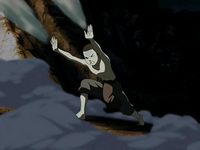
Aang performing two air blasts.
Air blast: A more offensive move involving a direct pulse or jet of strong wind from the hands, feet, or mouth. The force of the attack is generated more from the bender's own power, rather than assisted by momentum. The blast can reach further distances with greater accuracy and is used to inflict greater damage; Aang once used an air blast to completely shatter one of the Fire Navy's projectile rocks in mid-air with a single powerful kick,[5] and was also able to use two air blasts at once to defend against Combustion Man's unique firebending ability.[6]
Air bomb: A technique which creates a powerful, outward-moving air current in all directions around the bender. Usually performed after landing on the ground from above, this airbending form has great concussive force, and the capacity to completely blow away anything within its radius.[7]
Air bullets: A technique used by Aang. He caused two or more marbles to spin in a circle between his hands. It could be used to shoot small objects, like marbles, at very high speeds, similar to bullets, but Aang used the move to impress rather than to attack.[8]
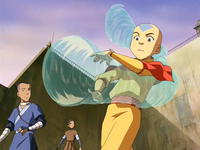
Aang creating an air funnel.
Air funnel: Similar to an air vortex but on a smaller scale, Aang inventively used this technique as a cannon by creating a small air funnel through which small rock projectiles could be loaded and fired out of the opposite end.[9]
Air manipulation: By using circular, evasive movements, airbenders build up massive momentum; this buildup of energy is released as massive power. It also allows for wind-based counter-attacks that knock opponents off-balance, mimicking the sudden directional shifts of air currents. Attacks vary from simple gusts of wind to miniature tornadoes and cyclones, maintaining the circular theme. Even a simple movement can create an air gust, and airbenders increase the power of their moves by performing larger sweeps and spins, using the momentum of their movement to simulate larger gusts. This is also demonstrated with their use of staffs or fans to increase or create precision within the air currents.[4]
Air punch/kick: Another more offensive move than is typical of airbending discipline, air punches or air kicks are small, compressed formations of air that can be fired off the fists or feet of an airbender. This is similar to many firebending abilities and the air blast, in the sense that it involves the firing of compressed or solidified air at an enemy in a disjunct fashion i.e. the bender does not create a single great stream of air. This move was seen when Aang produced several air punches in rapid succession toward a practice-Fire Lord dummy.[10] Avatar Korra was able to use two pairs of air punches in rapid succession and an air kick to knock Amon off his feet.[11] Korra used the air punch technique on the ground, spewing the bent air within a radius. Korra also used an air kick when fighting the police officers who were tracking down Kai.
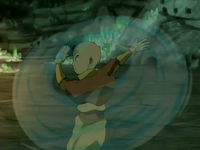
Aang using an air shield.
Air shield: The most common defensive tactic, though less powerful than the air barrier, it involves circling enemies, suddenly changing direction when attacked and evading by physical movement rather than bending. However, an airbender can still deflect as needed by throwing up gusts of air close to their bodies as a shield. This is rarely to stop attacks directly and more often pushes the attack aside and away, conserving energy and allowing them to turn the movement into an attack at the same moment. Since air can affect almost all physical objects, it can also be used to enforce the momentum of thrown objects or manipulate other objects (though requiring a higher degree of precision).[4]
Air suction: A technique used to bring people or things toward the airbender. It was used by Aang many times, such as when he pulled Professor Zei out of harm's way in Wan Shi Tong's Library, and when he took up the fans dropped on the ground to fight Zuko on Kyoshi Island.[8][12] Appa used this technique to steal cabbages from an animal trainer while his back was turned.[13] Although new to the art, Zaheer was also capable of this technique, as he used it during his prison break[14] and used this to bring his staff towards him in his fight with Kya.
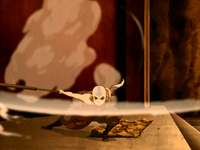
Aang using an air swipe.
Air swipe: The air swipe is both a defensive and offensive technique in which an airbender conjures a crescent-shaped structure of compressed air capable of deflecting colossal projectiles, such as the catapulted flaming rocks often used by the Fire Navy, and sending them off course or redirecting them back to the attacker.[15] Korra made powerful use of this technique while in the Avatar State to destroy Unalaq's dark spirits.[16]
Tenzin using an air wheel.
Air wheel: This is a modified version of the air ball. Air is rapidly spun around the airbender and carries the person as inside a wheel. It was shown to be able to cut through solid objects. This ability was used by Tenzin during the battle at the Equalist factory.[17]
Breath of wind: Very similar to the standard air jet, but created from the mouth and lungs. It requires extremely good breath control to employ effectively. Size and focus is more easily controlled, from narrow jets that can strike targets as small as insects, to large gale force gusts capable of cooling magma into solidified rock. This has been exhibited by both Aang and Roku.[18][19] By using this technique, the airbender can also magnify the sound waves generated by a whistle or another instrument. Aang demonstrated this technique while he was trying to lead a number of animals to the Agrarian Zone of Ba Sing Se, as he used airbending to blow his bison whistle, sending massive sound waves throughout the city to call all the animals.[20]
Enhanced agility: Air movements can also be used as a levitation aid. Airbenders jump high and far by riding on strong gusts of wind and can slow or deflect falls by creating cushions of air. The constant movement required by this art makes airbenders naturally flexible and agile. Even without bending they can easily maneuver around an opponent by ducking, jumping, and side stepping, appearing to flow around their opponents without expending any energy at all, letting the opponent tire themselves out and thus creating exploitable openings. This conservation of energy combined with high stamina gives them an advantage in prolonged combat.[4] Toph Beifong, a blind earthbender, who used her bending to tell where people were walking or running in relation to her, once told Aang that she could easily identify his walk by the fact that he had a very light step.
Enhanced speed: Airbenders enhance their movement in battle; they can run swiftly by decreasing air resistance around them and even sprint across or run up vertical surfaces by generating a wind current behind themselves to propel them forward. Aang has been shown using this to run many times faster than an average human and maintain this for very long periods, allowing him to travel long distances without gliding or jumping. When used by a skilled airbender, this technique can enable the airbender using it to travel at a speed almost too swift for the naked eye to be able to see properly.[4] A master airbender can use this technique to briefly run across water.[8]
Heat regulation: Airbenders are able to warm themselves using proper breathing technique, allowing them to thrive in frigid environments with relative ease.[21] Aang first demonstrated this in the Southern Water Tribe, maintaining his body heat without the need of a parka or any additional layers of clothing.[22]
Hypersensitivity: Airbenders possess a high level of sensory sensitivity which enables them to detect threats and perceive their surroundings through feeling air currents and the vibrations in the air, similar to how earthbenders use seismic sense to sense their environment using earth. For this reason, the Air Nomads shaved their heads in order to "free themselves" and have a stronger connection with the wind around them, increasing the technique's effectiveness when used. Daw first demonstrated this technique during a battle with bison rustlers, when he perceived and evaded an attack behind him by sensing the oncoming threat.[21]
Multiple target attacks: An airbender can send large, wide-spanning waves of air toward multiple enemies with one long, sweeping motion from an airbending staff or from the bender's limbs. Aang used the move extensively, often completely blowing opponents away.[4]
Airbending master level
Air blades: A more offensive move than its typical of airbending principle, this involves a focus; slicing air current that can cut through stone or timber with relative ease. This is frequently conjured with a staff rather than the body, using the narrow profile of the object to create a more focused and precise air movement. This move could prove fatal if used on an individual.[4]
Air grapple: Air is used to pull an object or a person to the bender's direction. This was demonstrated by Tenzin when he tried save Saikhan from a mecha tank outfitted with a magnet.[23]
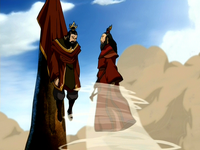
Air spout: Similar to the waterspout, master airbenders are able to rotate and control the direction of an air spout enough to levitate themselves off the ground and remain in the air for as long as they wish to or can maintain it. The first known use of this technique was by Avatar Wan during the battle in the Spirit Wilds, when he generated an air spout shortly after fusing with Raava in an attempt to mediate the escalating conflict. Avatar Wan would later use the technique to mediate the warring human factions after Harmonic Convergence by rising himself into the air while bending the other three elements.[24] Avatar Roku used this technique in order to speak face-to-face with Fire Lord Sozin, who was suspended in the air by an earth column.[19] In 100 AG, an enraged Aang used the air spout while in the Avatar State, destroying General Fong's fortress in the process.[25] An air spout was later performed by Tenzin when he fought several Equalists who tried to abduct him at City Hall during the battle for Republic City.[23] Avatar Korra later used this technique while in the Avatar State at the South Pole.[11]
Air vortex: A spinning funnel of air of varying size, the air vortex can be used to trap or disorient opponents as well as to deflect any objects thrown at it. Aang used this technique to form an air column during his duel with Bumi to throw aside a large boulder.[26] In the Avatar State, an air vortex can reach winds of up to 125 miles per hour.[source?]
Air wake: By running in a circle and instantly building massive momentum, a master airbender can shoot a blast of highly compressed air shaped like the user's body at a target. This move seems to have extremely high concussive force. It was first used by Aang in the Crystal Catacombs against Zuko.[27]
Flight: In the same way flying bison can fly and stay aloft for extended periods of time, a master airbender can achieve this same feat by generating and controlling air currents to form a 'cloud' like board under their feet and surfing through the air, thereby emulating flight.[4]

Aang creating a tornado.
Mini-tornado: This is a smaller scaled version of the air vortex which airbending masters can use as a means of both combat and transport. By encircling themselves in a spiraling air current, masters can travel at high speeds and even ascend near-vertical drops as shown by Aang during the battle of Wulong Forest, where he narrowly avoided a lightning blast from Fire Lord Ozai by creating a mini-tornado and moving to the top of a rock column.[28] Aang was also seen wielding this maneuver on the offensive against Combustion Man at the Western Air Temple, where he summoned the tornado with a kick in mid-air to conjure a powerful ranged attack.[29]
Avatar level airbending
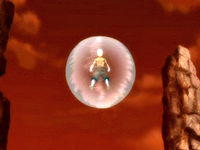
Aang hovering in an air sphere.
Air sphere: Aang was initially able only to hover for extended periods of time while in the Avatar State, but while fighting Fire Lord Ozai, Aang utilized this technique for flight. The Avatar flies at high-speeds while inside the air sphere, which also acts as a barrier to protect the bender during impacts, strong enough to withstand a high velocity impact with rock. Roku used a variation of this technique when defending his island from the volcano, and Wan and Korra both used it to restrain Vaatu in their respective battles against him.[24][30] The Air sphere, whilst in the Avatar state is shown to be able to break through solid pillers with both speed and ease. Whilst not in the Avatar state, Korra displays the air sphere being powerful enough to protect a small group from an explosive just meters away.
Augmented airbending moves: While in the Avatar State, all of the previously discussed airbending moves are generally augmented making them far more powerful in an Avatar than even a bending master. This ability of the Avatar State to increase the power of an Avatar's bending technique is not restricted, of course, to airbending; in fact an Avatar's power increases with all the bending styles once they have entered the Avatar State.[4]
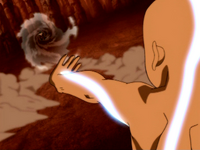
Aang creating a powerful blast of air.
Strong wind: It is possible for the Avatar to unleash extremely powerful winds. During the battle at Wulong Forest, while extinguishing three enormous fire whips, Aang unleashed a straightforward wind attack at Ozai. Ozai was shaken, but he apparently did not take much damage from the hit. However, the same attack did great damage to a nearby rock pillar, causing the thick pillar to crumble in a matter of seconds and causing it to collapse.[31]
Tornadoes/hurricanes: In addition to very large and powerful air movements, an Avatar level airbender can create massive tornadoes and hurricanes at will. Yangchen demonstrated this as part of showing the power the Avatar State had.[25]
Special techniques
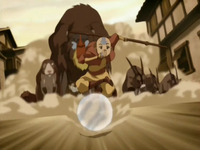
Aang using an air scooter to guide zoo animals out of Ba Sing Se's inner wall.
Air scooter: The air scooter, a form of ground transportation invented by Aang in 2 BG,[32] is a spherical "ball" of air that can be ridden balancing on it like a top. He used the technique in many episodes, usually to provide quick bursts of speed as well as to overcome vertical surfaces, including during the battle on the Fire Nation drill in order to scale the wall of Ba Sing Se.[7] The air scooter was also shown to be capable of levitating in the air for short periods, about five to ten seconds in a stationary position.[33] The air scooter was seen in the opening credits of every episode except the first,[4] and it first appeared in an actual episode when Aang used it to escape Zuko's ship.[3] It was Aang's invention of this technique that subsequently earned him his tattoos and title of a master at such a young age. In a flashback, it was shown that Aang tried to teach this move to his airbending friends. They all initially failed, but they eventually mastered the art well enough to develop a game that requires the use of the air scooter.[34] While he and Katara attempted to invite King Kuei to a meeting with Zuko, Aang met his fan club. There, he showed an enhanced air scooter, where the air scooter multiplied and grew from little balls. He was shown to use this technique much later in his life while chasing an escaped Yakone. The version Aang used was markedly larger than the one he used as a child, and it was revealed that it could also be used while standing upright.[35] Air scooters are not restricted to holding a single rider, as they can be used to transport others as well.[21]
Cloud manipulation: During Aang, Katara, and Sokka's stay at Makapu Village, it was shown that, because they are made with air and water, a skilled airbender or waterbender can manipulate clouds easily to create various shapes, used in that instance to provide a message to nearby villagers.[36] It was later used as a defense by Aang and his friends to disguise their flights on Appa while moving about the Fire Nation.[37]

Gliding: Although all airbenders can levitate or extend jumps via airbending, most if not all airbenders possess a glider for mid range flight. These hand-crafted portable wood and canvas structures can collapse into a staff for storage and as an aid when bending. In glider form, it is used in conjunction with bending to fly as long as the bender has the strength to maintain the air currents. With stronger winds, multiple people can be carried for short distances. As a normal staff, it can be used as a weapon in battle, to aid in bending, and even as a levitation aid when spun above the head like a helicopter propeller.[22]
Aang used his glider for windsurfing, but later destroyed his damaged glider, though it was replaced at the beginning of the invasion of the Fire Nation by a more advanced version created by the mechanist and his son Teo, which can also dispense snacks when the handle is twisted.[38]
When visiting Roku's past during the summer solstice, Aang saw a younger version of his old mentor, Monk Gyatso, using a variation of the usual flying, utilizing the glider as a makeshift board to surf on air.[19]
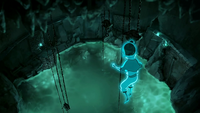
Jinora created a projection to explore the ruins of the Dai Li's fortress underneath Lake Laogai.
Spiritual projection: Master airbenders who have a strong connection with their spiritual side are capable of projecting their spirits into other locations. Through projection, an airbender is able to visit the spirit realm as well as explore underground or sealed locations by passing through solid matter. Airbenders can also use this technique to find individuals with whom they have a strong bond. During Harmonic Convergence, Jinora used an amplified variation of this ability to assist Avatar Korra during her battle with the Dark Avatar.[39] She used the technique once more to find where the Dai Li imprisoned airbenders in Ba Sing Se.[40]
Opposing bending art
Airbending is the most passive of the four arts, as many of its techniques center around mobility, evading and eluding the opponent. Along with this, the Air Nomads also taught pacifism.[26] Earthbending is the direct opposite of this. While the airbenders avoid or deflect oncoming attacks, earthbenders absorb them or overwhelm them with superior force. Airbenders are constantly moving in circles, while earthbenders require a firm root in one place to effectively bend.[1] However, firebending is the spiritual opposite of airbending. Airbenders are passive and peaceful, while firebenders are aggressive and passionate.
Like all of the bending arts, airbending is balanced out as to not be more or less powerful than the other arts, though it is easily the most dynamic and agile of the four. It is the skill and power of the user that determines victory.
Training tools
- Main article: Airbending training
In the process of mastering airbending, several instruments are used to help mastering this element.
The airball court doubles as a field for playing airball, as well as training several skills involved with airbending. Balance and dexterity are especially trained by this game. Accuracy is also trained, because the ball is mostly controlled by airbending as well.[41]
Spinning gates are designed so that one has to trust on one's evasive airbending maneuvers to successfully make one's way through the spinning gates. Those wishing to master the spinning gates have to be like a leaf, flowing with the wind instead of forcing one's way through.[42]
Weapons
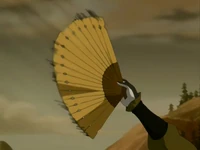
Unlike benders of other nations, who rarely use weapons with their bending, airbenders commonly use their signature staffs to augment their powers in battle. This is usually done by enhancing the air movements created by sweeps or thrusts of the staff. With the staff's narrow profile, the currents created can be more accurately controlled and even shaped into cutting blades. Metal fans can also be used in combination with airbending as seen by Avatar Kyoshi and Avatar Aang.[43]
While the group shopped in a weapons shop in the Fire Nation, Aang proposed the idea of the wind sword; he stated that an airbender could channel air from a sword hilt and swing it about like a blade, similar to a contained air slice.[44]
Weakness
Airbender principles regarding fatal moves: Though deemed the most dynamic of the bending arts, the most controversial aspect of airbending is its supposed lack of fatal moves, being a more defense-inclined art. This aspect in itself is a reflection of the principles held by the Air Nomads, which preaches the preciousness of all life and avoidance of violence whenever possible. But on the issue of principles, there are instances where an airbender has resorted to lethal force during a conflict; for example, Aang used an air slice to cleave a buzzard wasp, which had captured Momo, in half, though it is vital to note he was attacking it out of anger, something which airbenders are told to avoid.[45] Even Avatar Yangchen herself confessed to deeds that were in direct violation of her Air Nomad teachings, even though for the greater good.[46] Nevertheless, when applied correctly, airbending can be as lethal as any other bending art. Airbending moves such as the air blade and air blast could prove particularly fatal against living creatures seeing as they can cut through stone/timber and break entire rock-columns in half respectively. Another example of airbending lethality is Monk Gyatso's off-screen battle with the Fire Nation's invasion of the Southern Air Temple. Although an elderly and gentle person, when confronted with a life-threatening assault on his people, Gyatso's powerful airbending enabled him to eliminate many Fire Nation invaders before succumbing to fatigue or injury and ultimately death.[41] Yet another example of how dangerous and lethal airbending can be was in Roku's battle with Fire Lord Sozin, when Roku used it to destroy a good portion of the palace, though he was in the Avatar State when he unleashed the attack.[19]
Elemental symbol

The airbending symbol.
The symbol of airbending is a closed, counter-clockwise, inverted triple spiral triskele. This symbol was seen on the pendant on Monk Gyatso's prayer beads[41] and also appeared on Aang's prayer beads.[31]
Spirituality and airbending
Young airbenders were raised in one of the four air temples at each corner of the globe, hidden away atop mountain ranges on remote islands, where the strong breeze helped their airbending. The Northern and Southern Air Temples were exclusively male and staffed by airbender monks, who instructed young benders in their art, while the Eastern and Western Air Temples were exclusively female.[47] However, the Council of Elders had decided that Aang would finish his training at the Eastern Air Temple,[34] and it was at the same temple where he and several other young boys, were first introduced to their animal companions, the flying bison.[13]
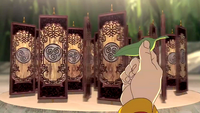
Airbending's key nature is to move freely with the flow; like a leaf in the wind.
An airbender is declared a master once he or she has fully mastered the thirty-six tiers of airbending and/or when he or she creates a new airbending technique;[48] Aang was the exception in this case, since he mastered only thirty-five tiers and made a new move. Airbenders who have mastered the element are marked as such by blue tattoos striping along the head and limbs, terminating in an arrow on the forehead, backs of the hands, and the tops of the feet. Male monks sport completely shaven heads, and female airbenders shave their foreheads, but they leave the back of their hair uncut. Avatar Yangchen was seen sporting this hairstyle while Aang learned about the Avatar State.[25] An airbender nun, Sister Iio, was shown to be in charge of the female airbenders of the Eastern Air Temple in a shared memory between Aang and Appa.[13]
Air Nomads generally espouse a philosophy of conflict avoidance and respect for all forms of life; an airbender will never seek a fight, and they will never seek to strike an opponent directly. This accounts for airbending's stress on defensive maneuvers and its apparent lack of fatal finishing attacks. Due to the spirituality of the Air Nomads in accordance to the size of its population, every Air Nomad retains bending abilities. The Air Nomads have the smallest population but the most increased spirituality, while benders in general make up only a small percentage of the larger, more populous nations.
Airbenders emphasize intuition and imagination; to an airbender, there is always another path to take, as air flows wherever it can. This makes airbending the most dynamic of all the bending arts,[26] and air itself is considered to be the element of freedom.[1][49]
The Air Nomad Genocide
- Main article: Air Nomad Genocide
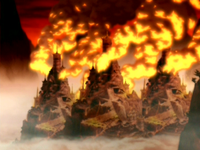
The destruction of the air temples.
In 0 AG, the airbenders were the victims of genocide at the hands of the Fire Nation. The temples were invaded, and all the airbender monks slaughtered in an effort to break the Avatar's cycle of reincarnation and ensure the Fire Nation's victory in their imperialist war.[5] Although some airbenders did survive, they were later lured into mountainous areas with relics from home and were killed, as later revealed by Admiral Zhao.[50]
Ironically, the only known survivor of the massacre is the very person the Fire Nation sought to kill in its quest for supremacy: The twelve-year-old airbender and Avatar, Aang, had run away from home shortly before the war began in earnest and became trapped in suspended animation, frozen in an iceberg near the South Pole.[22]
The last known vestiges of airbender culture included one surviving flying bison, Appa, and a winged lemur, Momo, both of whom were Aang's companions. The abandoned Northern Air Temple was colonized by displaced Earth Kingdom citizens, led by the mechanist.[51] The Eastern Air Temple was inhabited by Guru Pathik, who claimed to be an old friend of Monk Gyatso.[13] The Southern Air Temple is the only temple in which bodies of countless Fire Nation soldiers and Monk Gyatso's corpse are present.[41] Years later, Aang found an island filled with healthy flying bison and ring-tailed winged lemurs, which indicated that Appa was not the last surviving flying bison.[52]
Aftermath
Even 170 years after the Air Nomad Genocide, airbending culture survived through Aang's youngest son, Tenzin, and Tenzin's children, of whom three are also airbenders. The Air Acolytes were formed to carry on the traditions of Air Nomad culture. Both Tenzin's family and some of the Air Acolytes reside at Air Temple Island in Republic City while most of the acolytes live in each of the four ancient Air Temples. Prior to Harmonic Convergence, Tenzin's family were the last airbenders, thus were Amon's target in an effort to effectively erase one of the four bending arts from the world permanently. However, after Harmonic Convergence, airbenders emerged again across the world as several nonbenders obtained the ability.[14]
Rebuilding the Air Nation
Following the events of the Harmonic Convergence in 171 AG, airbending resurfaced in a number of nonbending citizens across the world. Avatar Korra, Tenzin, and the rest of Team Avatar set out to find the new airbenders and convince them to train with Tenzin at the Northern Air Temple to restore the Air Nation. The first new airbender who joined their group was a young boy named Kai.[53]
The Last Airbender
- "We airbenders learn to feel the energy behind the wind, not just the breeze on our skin. It's all about controlling energy."
- ―Aang to Sokka in The Last Airbender Movie Novelization.
In the film, airbending was portrayed much like it was in the cartoons. Its implementation also required sweeping, circular movements from Aang in order to create variable airbending techniques. He was also seen using rapid movements and kicks when creating the mini-tornado in front of the Northern Water Tribe council.
Aang was a master of airbending, shown by his tattoos. He was able to create an invisible wall of air in front or around him with one gesture, enough to repel two Fire Nation soldiers. He was able to jostle a Fire Nation soldier around without hitting the innocent bystander the soldier was holding hostage. He was also able to throw several Fire Nation soldiers into the air while Water Tribe Warriors standing in front of them were unaffected.
He also used airbending to augment his agility, as seen when he escaped from Zuko's ship near the beginning of the film, as well as for attacking in the Northern Air Temple. He could create a wind strong enough and wide enough to temporarily stun and keep apart two battling armies. Aang was able to manipulate fog while in the Northern Air Temple.
Connection
Airbending is based on the Baguazhang style of martial arts, also known as "circle walking" or "Eight Trigram Palm", along with a small hint of Xingyiquan, also known as "mind heart boxing". Baguazhang involves "smooth coiling and uncoiling actions". Such moves employ dynamic footwork, throws, and hand techniques.[54] These martial arts feature swift, evasive maneuvers that evoke the intangibility and explosive power of wind; drawing energy from the center of the abdomen.
Ba Gua, which utilizes circle walking of the Eight Trigrams, is known for its constant circular movement, which makes it difficult for opponents to attack directly or land a blow, a philosophy that is prevalent within airbending as well. Maneuvers employ the entire body with smooth coiling and uncoiling movements, utilizing dynamic footwork, open-hand techniques, punches, and throws. A common tactic is to maneuver behind an opponent and mirror their movements, preventing them from turning to face the practitioner, similar to the technique Aang used during his fight with Hide.[37]
Notable airbenders
- † indicates deceased during the series.
- ↓ indicates an airbender who has received his or her mastery tattoos.
Avatar: The Last Airbender
|
The Legend of Korra
Trivia
- Avatar Extras for "The Northern Air Temple" stated that all Air Nomads are airbenders. This would make the Nomads the only group with every individual being a bender. The creators also explain this is due to bending coming from spirituality.
- According to Aang's wanted poster, the Chinese word for airbending is 截氣神功, meaning "the divine art of halting air".[18]
- In the Greek dub, the word airbending has been translated as windbending, Ανεμοδάμασμα (Anemodamasma), instead of the pure Greek translation of airbending, Αεροδάμασμα (Aerodamasma). In The Legend of Korra, it is instead translated as Καμψη αέρα (Kampsi aera), meaning "bending of air".
- Airbending is also called windbending in the Finnish dub.
- The concept of having thirty six tiers of airbending and Aang not mastering one is similar to The 36th Chamber of Shaolin.
- An airbender's sneeze can create more propulsion than a modern day jet engine.[55]
- Airbenders are the second loudest snorers in the world, with flying bison being the first.[56]
References
See also
External links
- Baguazhang, the martial art upon which airbending is primarily based.
- Xingyiquan